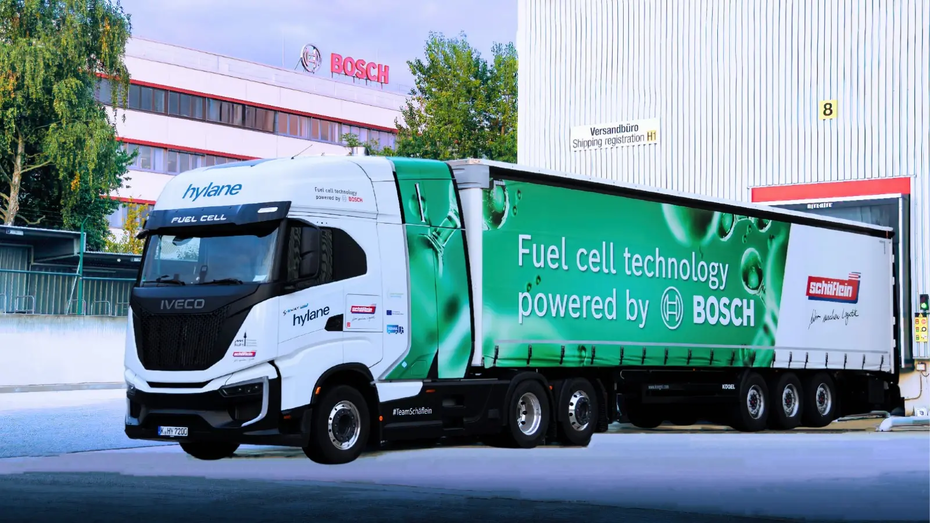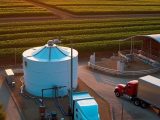
Hydrogen Fuel Cell Truck Powers First Live Logistics Operation at Bosch’s Nuremberg Plant
October 14, 2025We’re pumped to tell you that Bosch, the 1886-founded powerhouse in automotive and industrial tech, just kicked off regular logistics runs at its Nuremberg site with a brand-new hydrogen fuel cell truck. This isn’t a weekend demo—it’s daily grind stuff, built on an Iveco S-Way chassis decked out with Bosch Fuel Cell Power Module (FCPM). And yeah, it’s all about industrial logistics decarbonization, proving that real operations can go green without missing a beat.
Welcome to Nuremberg—an industrial juggernaut in northern Bavaria with over half a million people. Known for manufacturing chops, this city’s now turning its high-tech parks and car plants into a playground for sustainable transport solutions. By hauling 40 tons of freight on green hydrogen, Bosch is showing that you can stick to tight schedules and still ditch the diesel, all while syncing up perfectly with the Bavaria Hydrogen Strategy.
How It Works: The Idea Is Simple but Powerful
Here’s the gist: the heart of the operation is Bosch’s Bosch Fuel Cell Power Module, a neat package that churns out electricity by combining hydrogen and oxygen. Up top, the truck’s got high-pressure tanks holding about 70 kilos of hydrogen at 700 bar—enough juice to cruise up to 800 kilometers on one fill-up. The module keeps 200 kW humming along, jumps to 400 kW when you need a quick burst, and a little battery buffer so you can nail those acceleration moments and soak up braking energy. The result? A whisper-quiet, zero-emission ride. And guess what—refueling takes under 20 minutes, so it slots right into your existing shift patterns without a hitch.
You don’t have to rip out your whole fleet or rewrite your playbook. Just swap the diesel engine for a fuel cell and electric drive, plug into a hydrogen station, and the chemistry does the rest. No heavy overhauls, no fuss—just cleaner, greener hauls.
Solving Real-World Problems in Plant Logistics
This isn’t some lab-bound experiment—it’s tackling day-to-day challenges at Bosch’s Nuremberg plant head-on. The truck’s rolling under a usage-based rental deal with Hylane, who handles procurement, registration, and upkeep, while Schäflein takes it for a spin on a fixed 12,000 km annual route between warehouses, assembly lines, and loading docks. It’s a win-win: Bosch sidesteps big upfront costs, and operators see how neat a zero-emission platform can be.
Every trip streams live telematics on hydrogen use, refueling gaps, uptime stats, and maintenance quirks back to Bosch. That’s gold when you’re fine-tuning the next-gen Compact 190 and Compact 300 modules or plotting where to plant the next hydrogen pumps for maximum impact.
Environmental and Economic Upside
By swapping diesel fumes for pure H₂—and water as the only byproduct—Bosch expects to shave off several tons of CO₂ emissions each year—just from this one truck. Scale that across multiple sites and partners, and you’re talking serious cuts. It also kicks particulates and NOx to the curb, boosting air quality around the plant. On top of that, building out hydrogen stations and upkeep crews creates fresh jobs—an extra boost for local communities.
A Made in Germany Success Story
This demo is pure homegrown engineering: Bosch launched series production of the FCPM in 2023, shipping modules to customers in Europe and Asia ever since. Pairing it with the Iveco S-Way chassis shows OEMs and fuel-cell specialists can nail seamless integration. It’s German know-how in action, made for Bavaria’s future—and proof that regional players can lead the global hydrogen charge.
Building a Hydrogen Value Chain
Behind the scenes, regional partners are pumping out green hydrogen and rolling out refueling stations around Nuremberg. More trucks like this one mean stations get busier, costs edge down, and fresh investment follows. This live setup is right in tune with the Bavaria Hydrogen Strategy, aiming for a full-circle green hydrogen chain—from electrolysis and distribution to the big rigs on the road.
Collecting on-the-ground data about usage patterns and station turnover helps policymakers and energy providers size up future electrolyzer capacity, hydrogen fueling layouts, and grid tie-ins—key to building a robust hydrogen economy.
Next Steps and Wider Rollout
Looking ahead, Bosch will dive into the performance metrics, tweak efficiency, refine cooling tricks, and polish up the software. The big goal? Unleash commercially ready hydrogen trucks in the next few years, backed by a mature supply chain. We’re already in chats with other Bosch plants and logistics partners to scale this up—thinking dozens more trucks across Europe by 2026.
Driving the Future of Clean Logistics
At Bosch, we’re all about innovation that moves the needle. By putting a fully operational hydrogen fuel cell truck through its paces in everyday plant logistics, we’re proving that clean technology can keep pace with tough schedules. With smart partnerships, local expertise, and growing infrastructure, we’re not just talking about greener miles—we’re driving them. Keep your eyes peeled: the road to zero-emission transport is wide open, and it’s fueled by hydrogen.



 With over 15 years of reporting hydrogen news, we are your premier source for the latest updates and insights in hydrogen and renewable energy.
With over 15 years of reporting hydrogen news, we are your premier source for the latest updates and insights in hydrogen and renewable energy.